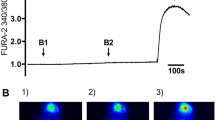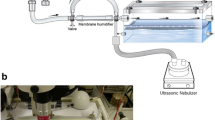Abstract
Purpose
It has been shown that airway ciliary function is impaired by several anesthetic or sedative drugs, which may predispose anesthetized or intensive care patients to respiratory complications, such as hypoxemia, atelectasis and pulmonary infection. We studied the effects of midazolam, propofol, dexmedetomidine, ketamine, fentanyl, thiopental and pentobarbital on ciliary beat frequency (CBF) in isolated and cultured rat tracheal epithelial (RTE) cells, to investigate their direct CBF action removing influences of non-epithelial cells.
Methods
Rat tracheal epithelial cells were purely isolated from tracheas of adult male Sprague-Dawley rats. After 14 to 21 days of culture, the images of motile cilia were videotaped using a phase-contrast microscope. Baseline CBF and CBF 30 or 50 min after administration of vehicle or one of the above agents were computer-analyzed.
Results
Midazolam (0.3–10 μM), propofol (1-100 μM), dexmedetomidine (1–100 nM), fentanyl (0.1–10 nM) and thiopental (30–300 μM) had no effect on CBF. Ketamine at a supraclinical dose (1000 μM) increased CBF (22 ± 13, mean ± standard deviation, % increase from baseline; baseline = 100%) significantly (P < 0.01). Fentanyl at a high clinical dose (100 nM) increased CBF significantly (10 ± 9%). Pentobarbital decreased CBF dose-dependently (100 μM, -2 ± 6%; 300 μM,-14 ± 18%; 1000 μM, -75 ± 5%) and reversibly (P < 0.01).
Conclusion
These results show that midazolam, propofol, dexmedetomidine and thiopental have no direct action on CBF in isolated RTE cells, whereas high doses of ketamine and fentanyl have direct ciliostimulatory actions and pentobarbital has a direct cilioinhibitory action.
Résumé
Objectif
La fonction ciliaire des voies aériennes est affectée par certains anesthésiques ou sédatifs qui peuvent prédisposer des patients anesthésiés, ou en soins intensifs, à ľhypoxémie, ľatélectasie et ľinfection pulmonaire. Les effets des midazolam, propofol, dexmédétomidine, kétamine, fentanyl, thiopental et pentobarbital sur la fréquence des battements ciliaires (FBC) de cellules épithéliales trachéales de rat (ETR), isolées et cultivées, ont été étudiés pour vérifier leur action directe sur la FBC tout en écartant ľinfluence des cellules non épithéliales.
Méthode
Des cellules épithéliales de trachée de rats, mâles adultes Sprague-Dawley, ont été isolées. Après 14 à 21 jours de culture, les images vidéo de cils mobiles ont été enregistrées en utilisant un microscope à contraste de phase. La FBC de base, et celle de 30 ou 50 min après ľadministration du véhicule, ou ďun des médicaments, ont été analysées par ordinateur.
Résultats
Les midazolam (0,3–10 μM), propofol (1–100 μM), dexmédétomidine (1–100 nM), fentanyl (0,1–10 nM) et thiopental (30–300 μM) n’ont pas eu ďeffet sur la FBC. La kétamine, à dose supraclinique (1000 μM), a augmenté la FBC (22 ± 13, moyenne ± écart type, % ďaugmentation; données de base = 100 %) de manière significative (P < 0,01). Le fentanyl, à forte dose (100 nM), a significativement augmenté la FBC (10 ± 9 %). Le pentobarbital a diminué la FBC en fonction de la dose (100 μM, -2 ± 6 %; 300 μM, -14 ± 18 %; 1000 μM, -75 ± 5 %) et de façon réversible (P < 0,01).
Conclusion
Les midazolam, propofol, dexmédétomidine et thiopental n’ont pas ďaction directe sur la FBC de cellules ETR isolées, tandis que de fortes doses de kétamine et de fentanyl ont une action ciliostimulante directe et que le pentobarbital a une action clio-inhibitrice directe.
Similar content being viewed by others
References
Lee RM, Forrest JB. Structure and function of cilia.In: Crystal RG, West JB (Eds) The Lung, Scientific Foundations, 2nd ed. Philadelphia: Lippincott-Raven; 1997: 459–78.
Wanner A, Salathé M, O’Riordan TG. Mucociliary clearance in the airways. Am J Respir Crit Care Med 1996; 154: 1868–902.
Farber NE, Pagel PS, Warltier DC. Pulmonary pharmacology.In: Miller RD (Ed.) Miller’s Anesthesia, 6th ed. Philadelphia: Elsevier Churchill Livingstone; 2005: 155–89.
Forbes AR, Horrigan RW. Mucociliary flow in the trachea during anesthesia with enflurane, ether, nitrous oxide, and morphine. Anesthesiology 1977; 46: 319–21.
Forbes AR, Gamsu G. Depression of lung mucociliary clearance by thiopental and halothane. Anesth Analg 1979; 58: 387–9.
Patrick G, Stirling C. Measurement of mucociliary clearance from the trachea of conscious and anesthetized rats. J Appl Physiol 1977; 42: 451–5.
Raphael JH, Selwyn DA, Mottram SD, Langton JA, O’Callaghan C. Effects of 3 MAC of halothane, enflurane and isoflurane on cilia beat frequency of human nasal epithelium in vitro. Br J Anaesth 1996; 76: 116–21.
Raphael JH, Butt MW. Comparison of isoflurane with propofol on respiratory cilia. Br J Anaesth 1997; 79: 473–5.
Hasani A, Spiteri MA, Pavia D, Lopez-Vidriero MT, Agnew JE, Clarke SW. Effect of temazepam on tracheobronchial mucus clearance. Thorax 1992; 47: 298–300.
Johnston M, Watts S, Drake-Lee A. In vitro effects of diazepam on human ciliary function. Acta Otolaryngol (Stockh) 1997; 117: 856–9.
Konrad F, Schraag S, Marx T, Kilian J, Goertz A. Effect of total intravenous anaesthesia with propofol, alfentanil, vecuronium on bronchial mucus transport velocity (German). Anästhesiol Intensivmed Notfallmed Schmerzther 1998; 33: 171–6.
Dormehl IC, Jacobs L, Maree M, Ras G, Hugo N, Beverley G. A baboon model for in vivo assessment of mucociliary lung clearance. J Med Primatol 1991; 20: 235–9.
Iravani J, Melville GN. Effects of drugs and environmental factors on ciliary movement (authors’s transl, German). Respiration 1975; 32: 157–64.
Karttunen P, Silvasti M, Saano V, et al. Effect of codeine on rat and guinea pig tracheal ciliary beat frequency. Arzneim-Forsch Drug Res 1991; 41: 1095–7.
Wang L, Tiniakov RL, Yeates DB. Peripheral opioidergic regulation of the tracheobronchial mucociliary transport system. J Appl Physiol 2003; 94: 2375–83.
Landa JF, Hirsh JA, Lebeaux MI. Effects of topical and general anesthetic agents on tracheal mucous velocity of sheep. J Appl Physiol 1975; 38: 946–8.
King M, Engel LA, Macklem PT. Effect of pentobarbital anesthesia on rheology and transport of canine tracheal mucus. J Appl Physiol 1979; 46: 504–9.
Kaartinen L, Nettesheim P, Adler KB, Randell SH. Rat tracheal epithelial cell differentiation in vitro. In Vitro Cell Dev Biol 1993; 29A: 481–92.
Ostrowski LE, Randell SH, Clark AB, Gray TE, Nettesheim P. Ciliogenesis of rat tracheal epithelial cells in vitro. Methods Cell Biol 1995; 47: 57–63.
Ohmoto N, Tokiwano K, Tanaka Y, Sumi A, Terachi S, Konno H. Exponential characteristics of power spectral densities caused by chaotic phenomena. J Phys Soc Jpn 1995; 64: 1104–13.
Hann HC, Hall AP, Rahael JH, Langton JA. An investigation into the effects of midazolam and propofol on human respiratory cilia beat frequency in vitro. Intensive Care Med 1998; 24: 791–4.
Reves JG, Glass PS, Lubarsky DA, McEvoy MD. Intravenous nonopioid anesthetics.In: Miller RD (Ed.). Miller’s Anesthesia, 6th ed. Philadelphia: Elsevier Churchill Livingstone; 2005: 317–78.
Shirakami G, Li D, Zhan X, Johns RA. Propofol stimulates ciliary motility via the nitric oxide-cyclic GMP pathway in cultured rat tracheal epithelial cells. Anesthesiology 2000; 93: 482–8.
Phillips PP, McCaffrey TV, Kern EB. The in vivo and in vitro effect of phenylephrine (neo synephrine) on nasal ciliary beat frequency and mucociliary transport. Otolaryngol Head Neck Surg 1990; 103: 558–65.
Ingels KJ, Meeuwsen F, Graamans K, Huizing EH. Influence of sympathetic and parasympathetic substances in clinical concentrations on human nasal ciliary beat. Rhinology 1992; 30: 149–60.
Curtis LN, Carson JL. Computer-assisted video measurement of inhibition of ciliary beat frequency of human nasal epithelium in vitro by xylometazoline. J Pharmacol Toxicol Meth 1992; 28: 1–7.
Boek WM, Romeijn SG, Graamans K, Verhoef JC, Merkus FW, Huizing EH. Validation of animal experiments on ciliary function in vitro. I. The influence of substances used clinically. Acta Otolaryngol (Stockh) 1999; 119: 93–7.
Salathe M. Effects of ß-agonists on airway epithelial cells. J Allergy Clin Immunol 2002; 110: S275–81.
Selwyn DA, Raphael JH, Lambert DG, Langton JA. Effects of morphine on human nasal cilia beat frequency in vitro. Br J Anaesth 1996; 76: 274–7.
Fukuda K. Intravenous opioid anesthetics.In: Miller RD (Ed.). Miller’s Anesthesia, 6th ed. Philadelphia: Elsevier Churchill Livingstone; 2005: 379–437.
Henthorn TK. Pharmacokinetics of intravenous induction agents.In: Bowdle TA, Horita A, Kharasch ED (Eds). The Pharmacologic Basis of Anesthesiology. New York: Churchill-Livingstone; 1994: 307–18.
Bullock R, Ward JD. Management of head trauma.In: Ayres SM, Grenvik A, Holbrook PR, Shoemaker WC (Eds). Textbook of Critical Care, 3rd ed. Philadelphia: W.B. Saunders; 1995: 1449–57.
Sato M, Hirakata H, Nakagawa T, Arai K, Fukuda K. Thiamylal and pentobarbital have opposite effects on human platelet aggregation in vitro. Anesth Analg 2003; 97: 1353–9.
Moriyama S, Nakamura K, Hatano Y, Harioka T, Mori K. Responses to barbiturates of isolated dog cerebral and mesenteric arteries contracted with KCl and prostaglandin F2á. Acta Anaesthesiol Scand 1990; 34: 523–9.
Author information
Authors and Affiliations
Corresponding author
Rights and permissions
About this article
Cite this article
Iida, H., Matsuura, S., Shirakami, G. et al. Differential effects of intravenous anesthetics on ciliary motility in cultured rat tracheal epithelial cells. Can J Anesth 53, 242–249 (2006). https://doi.org/10.1007/BF03022209
Accepted:
Published:
Issue Date:
DOI: https://doi.org/10.1007/BF03022209




